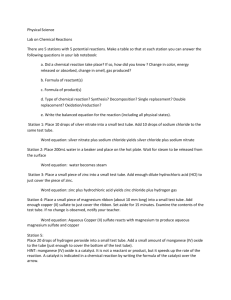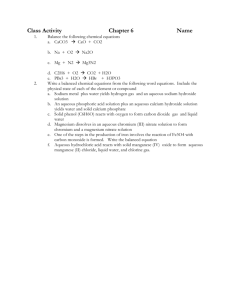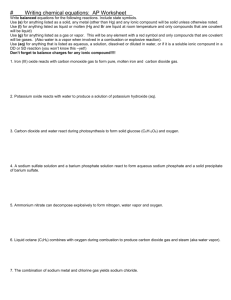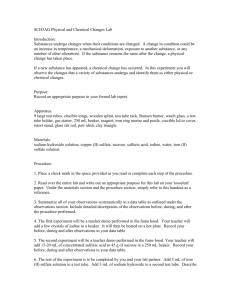Chemical Reactions Lab
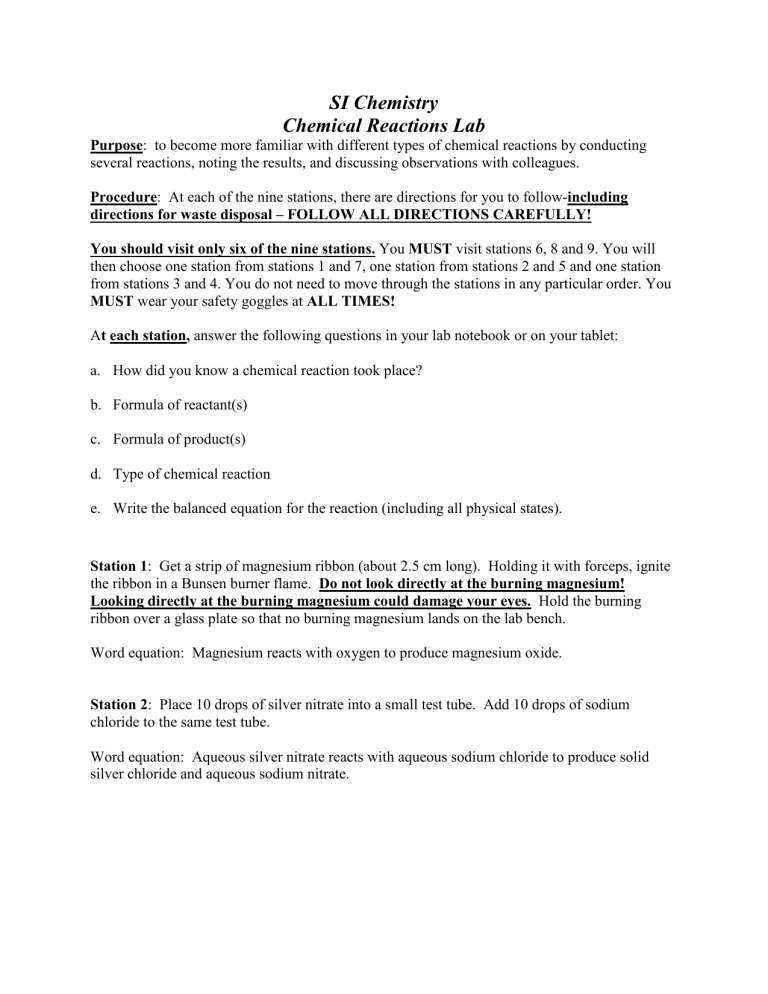
SI Chemistry
Chemical Reactions Lab
Purpose: to become more familiar with different types of chemical reactions by conducting several reactions, noting the results, and discussing observations with colleagues.
Procedure: At each of the nine stations, there are directions for you to follow-including
directions for waste disposal – FOLLOW ALL DIRECTIONS CAREFULLY!
You should visit only six of the nine stations. You MUST visit stations 6, 8 and 9. You will then choose one station from stations 1 and 7, one station from stations 2 and 5 and one station from stations 3 and 4. You do not need to move through the stations in any particular order. You
MUST wear your safety goggles at ALL TIMES!
At each station, answer the following questions in your lab notebook or on your tablet: a.
How did you know a chemical reaction took place? b.
Formula of reactant(s) c.
Formula of product(s) d.
Type of chemical reaction e.
Write the balanced equation for the reaction (including all physical states).
Station 1: Get a strip of magnesium ribbon (about 2.5 cm long). Holding it with forceps, ignite the ribbon in a Bunsen burner flame. Do not look directly at the burning magnesium!
Looking directly at the burning magnesium could damage your eyes. Hold the burning ribbon over a glass plate so that no burning magnesium lands on the lab bench.
Word equation: Magnesium reacts with oxygen to produce magnesium oxide.
Station 2: Place 10 drops of silver nitrate into a small test tube. Add 10 drops of sodium chloride to the same test tube.
Word equation: Aqueous silver nitrate reacts with aqueous sodium chloride to produce solid silver chloride and aqueous sodium nitrate.
Station 3: Place a small piece of zinc into a small test tube. Add enough dilute hydrochloric acid (HCl) to just cover the piece of zinc.
Word Equation: Zinc reacts with aqueous hydrochloric acid to produce aqueous zinc (II) chloride and hydrogen gas.
Station 4: Place a small piece of magnesium ribbon (about 10 mm long) into a small test tube.
Add enough copper (II) sulfate to just cover the ribbon. Set aside for 15 minutes. Examine the contents of the test tube. If no change is observed, notify your teacher.
Word equation: Aqueous Copper (II) sulfate reacts with magnesium to produce aqueous magnesium sulfate and copper.
Station 5: Place 10 drops of barium chloride into a small test tube. Add 10 drops of sodium sulfate to the same test tube.
Word equation: Aqueous barium chloride reacts with aqueous sodium sulfate to make barium sulfate and aqueous sodium chloride.
Station 6: Place 20 drops of hydrogen peroxide into a small test tube. Add a small amount of manganese (IV) oxide to the tube (just enough to cover the bottom of the test tube). HINT: manganese (IV) oxide is a catalyst. It is not a reactant or product, but it speeds up the rate of the reaction. A catalyst is indicated in a chemical reaction by writing the formula of the catalyst over the arrow.
Word equation: Aqueous hydrogen peroxide produces water and oxygen.
Station 7: USE THE FUME HOOD FOR THIS PROCEDURE!! Place a small amount of sulfur into a deflagration spoon. Heat over a Bunsen burner until the sulfur begins to burn.
Word equation: Sulfur reacts with oxygen to yield sulfur dioxide gas.
Station 8: Place a small amount (a small scoop) of hydrated copper (II) sulfate into a small test tube. Heat the hydrate over a Bunsen burner until the chemical reaction is complete (the reaction should be obvious). NOTE: a hydrate is a compound that contains water. The formula of a hydrate is written a little differently than formulas for other compounds. The formula for the hydrate of copper (II) sulfate is written CuSO
4
.
5H
2
O. This means there are five water molecules bound to one CuSO
4 molecule. (The correct name for this compound is copper (II) sulfate pentahydrate).
Word equation: When copper (II) sulfate pentahydrate is heated, anhydrous copper (II) sulfate and water vapor are produced. (Anhydrous means “no water”)
Station 9: Use the matches/lighter to ignite the methanol in the lamp by lighting the wick.
Extinguish the flame by putting the cap over the wick.
Word equation: Methanol reacts with oxygen to produce carbon dioxide gas and water.
Questions to answer in your lab notebook for the next class:
1.
Name five types of chemical reactions.
2.
What is a reactant in a chemical reaction?
3.
What is a product in a chemical reaction?
4.
Name four ways you can tell a chemical reaction has taken place.
5.
What does the symbol mean in a chemical equation?
6.
Give the four symbols for physical states of reactants and products, and tell what each means.
7. Why must chemical equations be balanced?
Conclusion: Was the purpose of this lab achieved? What evidence do you have to support your answer?
Revised January 11, 2008
